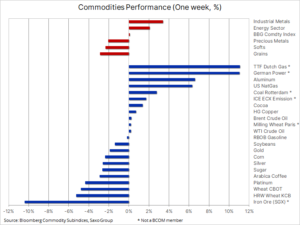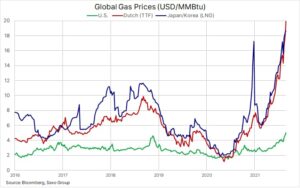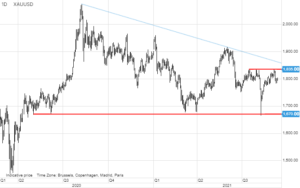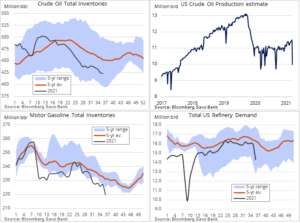Industrial metals in the lead. Gas Concerns
Last week, the Bloomberg commodity index was almost flat, but still did not deviate from levels recently recorded more than ten years ago. The factor keeping this index high is increasingly energy and industrial metals; While precious metals grapple with further problems, the agricultural sector has lost momentum, particularly after the Northern Hemisphere harvest season has begun, as a result of which analysts have firmed their forecasts.
In macroeconomic terms, the dollar remained unchanged, while US government bond yields remained optimal and fell after a series of successful auctions. In Europe, the ECB meeting did not contribute to greater volatility, as the announcement of a moderate reduction in asset purchases and the revision of growth and inflation forecasts were definitely in line with the consensus. In the equity market, weekly losses have been contained after previous losses from the containment of fiscal stimulus and concerns about economic growth; the latter emerged in response to the risk that further spread of the coronavirus would weaken the economic recovery and further increase inflation coupled with a supply shock.
Gas is still a hot topic
As in recent weeks, this sector has made the most profits, including in related markets such as coal, electricity and CO2 emissions. The prospect of very limited supply in the Northern Hemisphere winter due to reduced production and increased demand caused natural gas prices in Europe and Asia to soar, and last week the US gas futures contract with Henry Hub surpassed $ 5 / MMBtu for the next time the first since the beginning of 2014
US gas prices are backed by Hurricane Ida disruptions to supplies in the Gulf of Mexico. It temporarily removed about 1,7 billion cubic feet per day, or 2% of daily production in the United States, from the market, thus thwarting efforts to stockpile adequate inventories before the peak of winter demand. A good indicator of concerns about low winter deliveries is spread between futures contracts for March 2022, which corresponds to the end of winter in the United States, and contracts for the following month, i.e. April 2022. This spread, also called deadly due to often extreme volatility, increased to 0,88 USD / MMBtu, meaning utility providers and investors are ready to pay a 23% premium for March delivery compared to next month.
In Europe, Dutch TTF gas, the European benchmark, once again reached a record high of EUR 57,75 / MWh or USD 20 / MMBtu, corresponding to an oil price of almost USD 114 per barrel. This sector has benefited greatly from the reduction of global supplies due to strong economic growth, hot weather, and in Europe - also from the reduction of supplies from Russia. As a result, electricity bills have risen sharply, the prices of coal as a replacement have soared, and so have the cost of carbon offsetting.
Considering the scarcity of gas supplies in both Europe and Russia, the prospects for a winter shortage of this raw material are real, and the final bill will be paid by consumers and the industrial sector. Some companies may even be forced to cut production to reduce demand.
Grain market
After a very chaotic growing season in the United States, it lost some of its support, which pushed the prices of all three major crops to multi-year highs at the start of the season. Adverse weather conditions around the world at this time contributed to increased concerns about limited winter supply in the Northern Hemisphere.
READ: How to invest in raw materials, metals and agricultural commodities [GUIDE]
However, ahead of Friday's WASDE report, both maize and soybeans recorded a second consecutive week of losses, falling to their lowest levels in months. This was tied to expectations that the US Department of Agriculture would raise its production forecast for both crops after the recent improvement in weather forecasts ahead of harvest. In addition, the market has come under some pressure after Hurricane Ida disrupted a key export terminal on the Gulf of Mexico coast. The timing could not be worse given that both crops are about to begin harvesting soon, and Midwestern farmers ship much of their crops down the Mississippi River, from where they continue out into the world across the Gulf of Mexico.
Gold
After catching up on losses from the beginning of August gold lost value, again hitting a wall of resistance above $ 1 - an area that has already been tested and rejected six times since July. The biggest losses were recorded on Tuesday, when rising government bond yields, in the context of broad supply at auctions, contributed to the dollar strengthening after a disappointing decline following the publication of the US employment report.
Despite the prospect of an eventual start to the reduction of the extensive bond purchase program by the US Federal Reserve, we maintain the upward outlook for gold. This is based on our belief that the dollar may depreciate after it reaches its peak in US economic growth, and that gold at current prices is already reflecting higher, potentially up to 25 basis points, real yields. In addition, a further boom in commodity markets, primarily in the energy and industrial metals sectors, is likely to draw investors' attention back to inflation.
For now, the price is stuck, and potential bulls should wait for the break above $ 1 before engaging; while the arguments for the bears seem limited as real yields are currently optimal, hitting the lower end of the last range. While ten-year nominal yields do not break above the key resistance at 835%, potentially triggering a negative reaction, we believe the dollar will be the primary short-term benchmark for gold investors.
Platinum, industrial metals
Platinum, and palladium in particular, fell in response to subdued demand from the automotive industry, whose production is negatively affected by the continuing shortage of semiconductors. Palladium, which hit a record price of $ 3 / oz in May, has since dropped almost 018% to its lowest level in 30 months. The pressure on palladium was exacerbated by growth in early 12, which caused car makers to use more platinum in cars with gasoline engines. In our view, platinum remains a potentially strong candidate for recovery, not only because of the production shift mentioned above, but also because of its relative cheapness to gold, which last week hit its highest price in eight months at $ 2021.
READ ALSO: Palladium - how to invest in palladium? [Guide]
Industrial metals saw another solid week: aluminum and nickel have reached new long-term highs in view of the prospect of shrinking supply and increasing demand, including due to the clean energy transition and China's policy to reduce emissions in energy-intensive industries producing aluminum, nickel and steel. Aluminum has received an additional boost due to political tensions in Guinea, the main source of supply of bauxite, the raw material used to produce alumina, which is processed into aluminum.
About the Author
 Ole Hansen, head of department of commodity market strategy, Saxo Bank. Djoined a group Saxo Bank in 2008. Focuses on providing strategies and analyzes of global commodity markets identified by foundations, market sentiment and technical development. Hansen is the author of the weekly update of the situation on the goods market and also provides customers with opinions on trading goods under the #SaxoStrats brand. He regularly cooperates with both television and printed media, including CNBC, Bloomberg, Reuters, Wall Street Journal, Financial Times and Telegraph.
Ole Hansen, head of department of commodity market strategy, Saxo Bank. Djoined a group Saxo Bank in 2008. Focuses on providing strategies and analyzes of global commodity markets identified by foundations, market sentiment and technical development. Hansen is the author of the weekly update of the situation on the goods market and also provides customers with opinions on trading goods under the #SaxoStrats brand. He regularly cooperates with both television and printed media, including CNBC, Bloomberg, Reuters, Wall Street Journal, Financial Times and Telegraph.
Copper, used in everything from wires and electronics to electric cars, and as such a good indicator of global growth and activity, remains the industrial metal of choice among casual and speculative investors looking to gain exposure to the sector. In addition, the easy access to trade in copper around the world, along with its relatively high liquidity on the three major exchanges in New York, London and Shanghai, make the price of copper often responsive not only to its fundamentals, but also to global macroeconomic events.
In retrospect, we can see that copper, one of the pillars of the so-called The "green" transformation continues to show a downward trend, but at the same time managed to create a double bottom around $ 3,95 / lb. While waiting for a higher maximum, which will attract a new momentum, the risk of a deeper correction cannot be ruled out, but in our opinion copper remains a profitable investment in the context of new strengthening and possible additional weakening.
Oil price
Crude oil stabilized in a relatively narrow range, close to the upper end of our preferred range of $ 65-75. Extended downtime in the Gulf of Mexico following Hurricane Ida removed more than 20 million barrels from the marketand refineries struggled to resume operations after power cuts and floods. This situation was reflected in the price-favorable but highly distorted weekly inventory report, in which the US Energy Information Administration cut production by 1,5 million barrels per day and refining demand by 1,6 million barrels per day.
The weekly volatility was fueled by news that China for the first time reached into its enormous reserves to "ease the pressure from rising commodity prices". However, this was back in July, so it brought nothing new apart from confirming that the world's two largest consumers feel uncomfortable with prices well above current levels and can therefore do so again if needed. In addition to observing the overall level of risk appetite, oil traders should pay attention to the Gulf of Mexico and the prospect of a return to normal production and refinery operations. In addition, this week's main topic will be the monthly OPEC and IEA reports on the crude oil market, as well as the question of whether the authors of these publications, like the EIA in their Short-Term Energy Outlook (STEO), will lower the forecasts for the global in response to the continued negative mobility of the Covid-19 pandemic.






















![Forex Club – Tax 9 – Settle tax on a foreign broker [Download the Application] Forex Club - Tax 9](https://forexclub.pl/wp-content/uploads/2024/02/Forex-Club-Podatek-9-184x120.jpg?v=1709046278)
![Trading View platform – solutions tailored to the needs of traders [Review] trading view review](https://forexclub.pl/wp-content/uploads/2024/03/trading-view-recenzja-184x120.jpg?v=1709558918)
![How to connect your FP Markets account to the Trading View platform [Guide] fp markets trading view](https://forexclub.pl/wp-content/uploads/2024/02/fp-markets-trading-view-184x120.jpg?v=1708677291)
![How to invest in ChatGPT and AI? Stocks and ETFs [Guide] how to invest in chatgpt and artificial intelligence](https://forexclub.pl/wp-content/uploads/2023/02/jak-inwestowac-w-chatgpt-i-sztuczna-inteligencje-184x120.jpg?v=1676364263)


![WeWork – the anatomy of the collapse of a company valued at $47 billion [WeWork, part II] wework bankruptcy story](https://forexclub.pl/wp-content/uploads/2024/04/wework-bankructwo-historia-184x120.jpg?v=1711729561)
![Adam Neumann – the man who screwed up Softbank [WeWork, part AND] adam neumann wework](https://forexclub.pl/wp-content/uploads/2024/04/adam-neumann-wework-184x120.jpg?v=1711728724)





![How to transfer shares to another brokerage office [Procedure description] how to transfer shares to another brokerage house](https://forexclub.pl/wp-content/uploads/2024/03/jak-przeniesc-akcje-do-innego-biura-maklerskiego-184x120.jpg?v=1709556924)

![The most common mistakes of a beginner trader - Mr Yogi [VIDEO] Scalping - The most common mistakes of a beginner trader - VIDEO](https://forexclub.pl/wp-content/uploads/2024/03/Scalping-Najczestsze-bledy-poczatkujacego-tradera-VIDEO-184x120.jpg?v=1711601376)
![Learning patience: No position is also a position - Mr Yogi [VIDEO] Scalping - Learning patience - No position is also a position - VIDEO](https://forexclub.pl/wp-content/uploads/2024/03/Scalping-Nauka-cierpliwosci-Brak-pozycji-to-tez-pozycja-VIDEO-184x120.jpg?v=1710999249)
![When to exit a position and how to minimize losses - Mr Yogi [VIDEO] Scalping - When to exit a position and how to minimize losses - VIDEO](https://forexclub.pl/wp-content/uploads/2024/03/Scalping-Kiedy-wyjsc-z-pozycji-i-jak-minimalizowac-straty-VIDEO-184x120.jpg?v=1710336731)






















